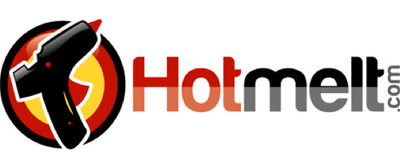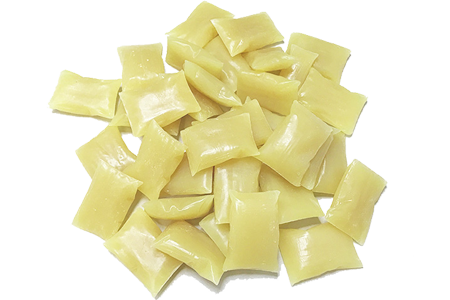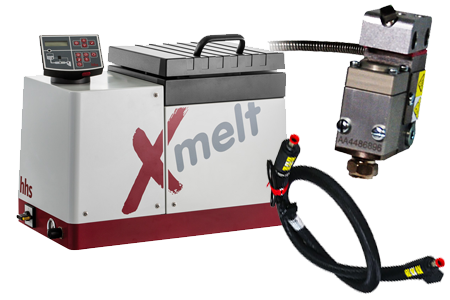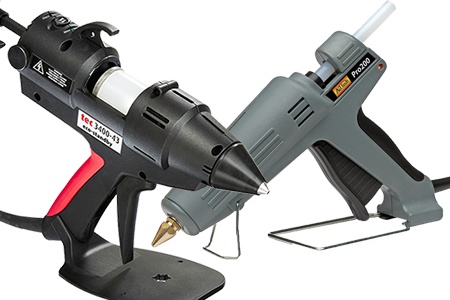Table of Contents
- What Are Hot Melt Adhesives?
- Ethylene Vinyl Acetate (EVAs)
- Metallocenes
- Polyurethanes (PURs)
- Amorphous Poly Alpha Olefin (APAOs)
- Polyamides (PAs)
- Copolyamides
- Copolyesters
- Pressure Sensitive Adhesives (PSAs)
- Fugitive Hot Melts
- Comparison Chart
- Choosing the Right Type of Hot Melt Glue
- FAQs
What Are Hot Melt Adhesives?
Hot melts are thermoplastic adhesives that are solid at room temperature. They are melted by heat to a liquid form and then applied to the substrate. The hot melt will then solidify to form a bond between the substrates.
They were initially developed to overcome the limitations of water-based adhesives, especially their poor performance in humid or wet environments. Hot melt glues are a versatile type of adhesive widely used for packaging, product assembly, woodworking, and industrial applications.
Hot melts generally set quickly as they cool, forming mechanical and sometimes physical bonds, making them suitable for fast assembly processes. Hot melts also provide rapid bonding without drying time, which makes them ideal for high-speed production.
Comparing the Different Types of Hot Melt Adhesives
Hot melts include a diverse collection of adhesives. There are several different kinds of hot melt glues, and each has its own advantages and disadvantages. If you are looking for a hot melt for your application, it is important to understand these differences to ensure you choose the right type of hot melt adhesive for your needs.
Ethylene Vinyl Acetate (EVAs)
Ethylene vinyl acetate or EVA adhesives are the most common type of hot melt glue. They are a copolymer-based thermoplastic made of ethylene and vinyl acetate units. They bond well to cellulosic materials such as paper and cardboard. As a result, they are commonly used in paper, packaging, and assembly applications.
Compared to other kinds of hot melt adhesives, EVAs can bond to a more diverse number of substrates and have one of the widest temperature ranges. They also tend to be one of the most cost-effective hot melt types.
Explore our full collection of EVA hot melt adhesives.
Metallocenes
Metallocene hot melts are made from metal-catalyzed polyethylene. Compared to traditional hot melts, metallocenes have improved flow properties, better bonding strength, and lower application temperatures. They are also less dense and voluminous. As a result, less glue is required to reach optimal strength and get lasting bonds.
Metallocenes also have a long pot life, produce minimal odor, and lead to minimal stringing. They are ideal for high-speed packaging applications where cleanliness and low adhesive char are critical. Because they are often considered a premium product, they do tend to be more expensive than other types of hot glues like EVAs.
Browse our selection of metallocene hot melts.
Polyurethanes (PURs)
One of the biggest benefits of PUR hot melts is their great strength. Unlike traditional hot melts, PUR hot melts will react with moisture in the air and undergo a chemical change instead of just a thermal bond. As a result, the bond will continue to strengthen over the next several hours, and that adhesive is not able to be remelted. While PURs tend to be more expensive than other chemistries of hot melt adhesives, they can also be used to replace more costly structural adhesives.
On top of their great strength, PUR adhesives offer a fast set time as well as great resistance to heat, chemicals, and moisture. These properties make PURs ideal for applications such as woodworking, automotive interiors, packaging, panel assembly, and more.
Shop our PUR hot melt adhesives.
Amorphous Poly Alpha Olefin (APAOs)
In their truest form, amorphous poly alpha olefin or APAO hot melts are made up entirely of propylene, but they are also often combined with ethylene or butene-1 to change the characteristics of the adhesive. Compared to other hot melt adhesives like EVAs, they have superior heat resistance. They are also known for being chemically inert, so they have a higher resistance to moisture, oils, and other chemicals.
APAOs also tend to have long open times, cleaner machining, excellent cold resistance, and good flexibility. They are commonly used in packaging, hygiene products, automotive assembly, electronic assembly, and more.
Explore our available APAO adhesives.
Polyamides (PAs)
Polyamide hot melt adhesives are a high-performance adhesive known for their excellent heat resistance. Compared to other hot glue types like EVAs, they also tend to have better chemical and oil resistance, so they are desirable in applications where these properties are necessary, such as in automotive assembly. They are also used in woodworking, low-pressure molding, and electrical applications.
On the flip side, polyamides do have a shorter shelf life than other types of hot melt adhesive glues and can be more difficult to run in bulk tanks.
Explore our polyamide hot melt adhesive collection.
Copolyamide Hot Melt Adhesives
Copolyamide hot melt adhesives are a type of polyamide hot melt that are made from multiple polyamide monomers. Like polyamides, they are also known their great heat resistance and chemical resistance, but they are engineered to have enhanced flexibility and improve adhesion to a wider range of substrates. They are suitable for a wide range of applications, including textiles, footwear, furniture, automotive interiors, and more.
Explore our full range of copolyamide hot melt adhesives.
Copolyester Hot Melt Adhesives
Copolyester hot melts are a thermoplastic made up of multiple polyester monomers and are best known for their great strength as well as high resistance to chemicals and high temperatures. They offer a good balance of toughness and flexibility.
Depending on the product, they can be used to bond foam, fabrics, metals, plastics, and more. They can also come in powder form. Copolyester adhesives are commonly used with textiles, apparel, and automotive interiors.
Find the right copolyester hot melt adhesive for your application.
Pressure Sensitive Hot Melt Adhesives
Pressure sensitive adhesives (PSAs) are a special type of hot melt adhesive that is designed to remain tacky. With a small amount of pressure, they are able to provide immediate adhesion without requiring heat or solvents. The strength of the bond will depend on the specific product being used.
PSA hot melts are typically made of rubber, acrylics, or silicone. They can bond to plastics, paper, metals, glass, wood, and other materials, but they can lack the heat resistance of other chemistries of hot melt glues. They are a popular choice for marketing materials, packaging, bookbinding, labeling, and more.
Shop our pressure sensitive adhesives.
Fugitive Hot Melt Adhesives
Fugitive hot melts, also known as booger glue or credit card glue, are a type of hot melt adhesive that is unique because it is formulated to create a temporary bond. They are designed to be strong enough to hold parts securely during processing and transport but easy enough to be removed later with a small amount of force. Used correctly, they should leave no residue behind on the substrate.
They are especially common in marketing materials like direct mailers, magazine inserts, and POP displays.
Browse our selection of fugitive hot melt adhesives.
Comparing Hot Melt Adhesive Types
Choosing the right hot melt adhesive depends on multiple factors and can make all the difference for your finished product. We created a chart of the differences between the most common types of hot melt chemistries to help guide your selection.
|
Adhesive Type |
Chemical Makeup |
Properties & Advantages |
Limitations |
Common Applications |
|
EVA (Ethylene Vinyl Acetate) |
Ethylene + vinyl acetate copolymer |
Wide temperature range, cost-effective, versatile |
Not as clean-running or strong as premium types |
Packaging, paper bonding, general assembly |
|
Metallocene |
Metal-catalyzed polyethylene |
Low density, clean-running, low application temp |
More expensive than EVAs |
High-speed packaging |
|
PUR (Polyurethane Reactive) |
Polyurethane prepolymer |
extremely strong, great chemical/heat/moisture resistance |
Higher cost, cannot be remelted |
Woodworking, automotive interiors, panel assembly, packaging |
|
APAO (Amorphous Poly Alpha Olefin) |
Amorphous polypropylene-based |
Chemically inert, long open time, superior heat resistance, good chemical/oil resistance |
Slower set time, not as strong as PURs or PAs |
Packaging, hygiene products, automotive, electronics |
|
Polyamides (PA) |
Polyamide resins |
High heat/chemical/oil resistance, durable, high temperature stability |
Shorter shelf life, harder to run in bulk tanks |
Automotive assembly, woodworking, electrical, low-pressure molding |
|
Copolyamide |
Polyamide copolymers |
Enhanced flexibility, high heat/chemical resistance |
Higher cost, specific processing needs |
Textiles, footwear, furniture, automotive interiors |
|
Copolyester |
Polyester copolymers |
flexible, chemically resistant, high temperature resistance |
Substrate-sensitive, generally higher cost |
Textile bonding, apparel, automotive interiors |
|
Pressure Sensitive Hot Melt (PSA) |
Rubber, acrylic, or silicone bases |
Permanently tacky, immediate adhesion with heat or solvent |
Lower heat resistance, bond strength varies |
Labels, packaging, bookbinding, marketing materials |
|
Fugitive Hot Melt |
EVA or PSA blends |
Temporary hold, clean removal |
Not for permanent applications |
Direct mailers, magazine inserts, POP displays |
Choosing the Right Type of Hot Melt Glue
Different hot melts have different properties and applications. Now that you know more about the different hot melt glue types, you may have a better idea of what you need for your application. Some key factors to consider include:
-
Substrate compatibility
-
Application
-
Bond strength and flexibility
-
Environmental conditions
-
Production process and equipment requirements
-
Cost
If you still need help, you are in luck. We have adhesives experts who are able to offer guidance and point you in the right direction. Get a product recommendation today.

























